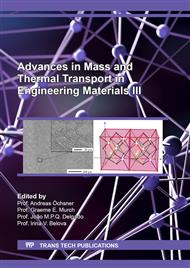[1]
Z. Ismail, I. Abdullah, N. Mustapha, N. Amin, A power-law model of blood flow through a tapered overlapping stenosed artery, Applied Math. Comp. 195 (2008) 669-680.
DOI: 10.1016/j.amc.2007.05.014
Google Scholar
[2]
M. Moayeri, G. Zendehbudi, Effects of elastic property of the wall on flow characteristics through arterial stenoses, Journal Biomech. 36 (2003) 525-535.
DOI: 10.1016/s0021-9290(02)00421-9
Google Scholar
[3]
S. Chakravarty, Effects of stenosis on the flow-behaviour of blood in an artery, Int. J. Eng. Science 25 (1987) 1003-1016.
Google Scholar
[4]
S. Chakravarty, A. Datta, P. Mandal, Analysis of nonlinear blood flow in a stenosed flexible artery, Int. J. Eng. Science 33 (1995) 1821-1837.
DOI: 10.1016/0020-7225(95)00022-p
Google Scholar
[5]
S. Chakravarty, A. Datta, P. Mandal, Effect of body acceleration on unsteady flow of blood past a time-dependent arterial stenosis, Math. Comp. Modelling, 24 (1996) 57-74.
DOI: 10.1016/0895-7177(96)00090-8
Google Scholar
[6]
R. F. Dutra, F. S. Zinani, L. A. O. Rocha, C. Biserni, Constructal design of an arterial bypass graft, Heat Transfer 49 (2020) 4019-4039.
DOI: 10.1002/htj.21693
Google Scholar
[7]
L. A.O. Rocha, S. Lorente, A. Bejan, Constructal theory in heat transfer, Handbook of Thermal Science and Engineering, Springer, Cham, (2018).
DOI: 10.1007/978-3-319-26695-4_66
Google Scholar
[8]
C. Bertolotti, V. Deplano, Three-dimensional numerical simulations of flow through a stenosed coronary bypass, Journal Biomech. 8 (2000) 1011-1022.
DOI: 10.1016/s0021-9290(00)00012-9
Google Scholar
[9]
J. Vimmr, A. Jonasova, O. Bublik, Effects of three geometrical parameters on pulsatile blood flow in complete idealised coronary bypasses, Comp. & Fluids 69 (2012) 147-171.
DOI: 10.1016/j.compfluid.2012.08.007
Google Scholar
[10]
A. Bejan, Convection Heat Transfer, John Wiley & Sons, New York, (2013).
Google Scholar
[11]
R. B. Bird, W. E. Stewart, E. N. Lightfoot, Transport phenomena, Vol. 1, John Wiley & Sons, New York, (2006).
Google Scholar
[12]
J. R. Womersley, Method for the calculation of velocity, rate of flow and viscous drag in arteries when the pressure gradient is known, The Journal of Physiology 27 (1955) 553-563.
DOI: 10.1113/jphysiol.1955.sp005276
Google Scholar
[13]
I. B. Celik, U. Ghia, P. J. Roache, C. J. Freitas, Procedure for estimation and reporting of uncertainty due to discretization in CFD applications, Journal of Fluids Eng.-Transactions of the ASME, 130, (2008) 078001.
DOI: 10.1115/1.2960953
Google Scholar
[14]
X. He, D. N. Ku, Pulsatile flow in the human left coronary artery bifurcation: average conditions, Journal Biomech. Eng. 118 (1996) 74-82.
DOI: 10.1115/1.2795948
Google Scholar


